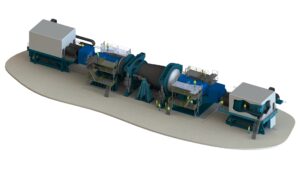Shipping costs between China and the UK increased by over 350 per cent between 2020 and 2021, according to China-Britain Business Council. Largely due to the pandemic, but also the war in Ukraine and Brexit, these issues have created component shortages and forced many manufacturers to raise prices. Here, Jonathan Parry, Senior Vice President & MD Europe for electrical connector specialist PEI-Genesis, discusses three steps businesses can take to give customers stability in uncertain times.
The war in Ukraine has caused fuel prices to surge, forcing an increase in freight costs for all modes of transportation. It has also disrupted the rail transport route connecting China and Europe, which had already become competitive due to the rise in consumer demand during the COVID-19 pandemic.
Although global shipping prices have started to stabilise in 2022, data provided by Freightos indicates that transpacific and transatlantic rates are still 180 and 240 per cent higher, respectively, than early December 2019.
In the US, labour disputes, rail backlogs, and rising diesel prices are all causing supply chain problems.
These are all issues businesses have no control over. However, there are steps and strategies that can help to mitigate these and build a secure operational platform to provide stability for customers.
Localisation
Over the past two years, mismatching lockdowns worldwide have caused many containers to become stranded at ports. Similarly, competition to fill the gap caused by issues in the China–Europe route has forced ships to be diverted to parts of Africa or South Asia.
This dependence on a global supply chain has increased the time it takes for many companies to service their customers, forcing them to localise. By bringing their manufacturing process closer to consumers, businesses can ensure a continuity of service and speedy supply, regardless of future global challenges.
The Just in Case strategy
Before the pandemic, many businesses relied on the just-in-time (JIT) strategy. This inventory management strategy allows manufacturers to align materials orders from suppliers with their production schedules, increasing efficiency and minimising inventory costs.
This strategy works well when supply chains are reliable. However, the pandemic forced manufacturing to shut down, and when the markets reopened, there was a jump in demand. This, coupled with the other issues mentioned previously, means that JIT no longer works for many companies.
To help ensure a continuity of service for customers, manufacturers can invest in holding more stock, also known as the just-in-case (JIC) strategy. JIC aims to minimise the likelihood that a product will sell out, serving as a cushion in the event of supply disruptions.
By ensuring the availability of products, businesses can avoid permanently losing customers and suppliers. They can also prevent a supply chain collapse.
Reconnect with customers
Pandemic lockdowns prevented businesses from meeting with their clients and building relationships. With most restrictions now lifted, it is a great opportunity for companies to reconnect with their customers by investing in their field sales coverage.
This is especially important for companies who operate in regions that contain different languages and cultures, as having localised sales teams can provide a tailored service based on the needs of the customers in these regions.
PEI-Genesis is taking these steps to invest in providing stability for its customers globally. These investments are centred around its three pillars: speed, inventory, and being a trusted advisor to its customers.
To provide speed and keep its 48-hour promise to its customers, it has opened an additional manufacturing facility in Philadelphia, USA, alleviating the pressure on its existing South Bend facility. It has also opened a facility in Zhuhai, China, because customs clearance meant it took over ten days to ship products from its other sites in the Asia-Pacific (APAC) region.
PEI-Genesis has also invested in its inventory. It has ten million dollars more component stock than it did this time last year. This offers unrivalled availability for customers as it can offer the widest range of part numbers and selections.
Finally, the company is investing in being a trusted advisor. This means having experts in each market to drive customer relations. For example, in APAC, the company has expanded its sales force to cover ten out of fourteen APAC markets, opening its most recent sales office in Singapore. This enables it to bring solutions with new and existing products, while allowing it to give a more bespoke service to customers of different languages and cultures.
To find out more about how PEI-Genesis is mitigating the effects of global issues on its customers by holding a large stock of its electrical connectors, visit www.peigenesis.com.

 Instrumentation Monthly Test | Measurement | Control
Instrumentation Monthly Test | Measurement | Control








